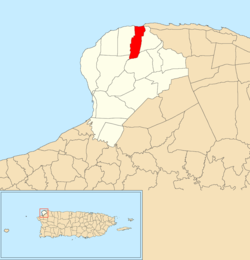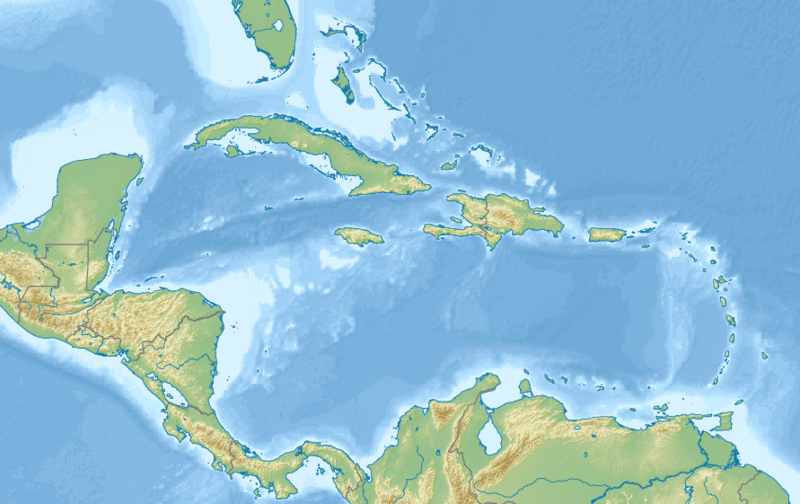Aguacate, Aguadilla, Puerto Rico
Aguacate is a barrio in the municipality of Aguadilla, Puerto Rico. Its population in 2010 was 1,525.[3][4][5]
Aguacate | |
|---|---|
Barrio | |
 | |
 Aguacate Aguacate, Aguadilla, Puerto Rico  Aguacate Aguacate (Caribbean) | |
| Coordinates: 18°29′59″N 67°06′41″W[1] | |
| Commonwealth | |
| Municipality | |
| Area | |
| • Total | 1.65 sq mi (4.3 km2) |
| • Land | 1.48 sq mi (3.8 km2) |
| • Water | 0.17 sq mi (0.4 km2) |
| Elevation | 203 ft (62 m) |
| Population (2010) | |
| • Total | 1,525 |
| • Density | 1,030.4/sq mi (397.8/km2) |
| Source: 2010 Census | |
| Time zone | UTC−4 (AST) |
History
The United States took control of Puerto Rico from Spain in the aftermath of the Spanish-American War under the terms of the Treaty of Paris of 1898. In 1899, the US conducted its first census of Puerto Rico finding that the combined population of Aguacate barrio and Arenales was 991.[6]
Sectors
Barrios (which are like minor civil divisions)[7] in turn are further subdivided into smaller local populated place areas/units called sectores (sectors in English). The types of sectores may vary, from normally sector to urbanización to reparto to barriada to residencial, among others.[8][9][10][11]
The following sectors are in Aguacate barrio:[12]
Reparto Los Robles, Reparto Roldán, Sector Calero, Sector Villa Min, Urbanización Nuevo San Antonio, Urbanización Quintas de San José, Urbanización Ramón Marín, Urbanización Villa Aurelia, Urbanización Villa del Paraíso, Urbanización Villa Jiménez, Urbanización Villa Montaña, Urbanización Villa Sotomayor, Urbanización Villas del Mar, and Villa Olga.
References
- "US Gazetteer 2019". US Census. US Government.
- U.S. Geological Survey Geographic Names Information System: Aguacate barrio
- Picó, Rafael; Buitrago de Santiago, Zayda; Berrios, Hector H. Nueva geografía de Puerto Rico: física, económica, y social, por Rafael Picó. Con la colaboración de Zayda Buitrago de Santiago y Héctor H. Berrios. San Juan Editorial Universitaria, Universidad de Puerto Rico,1969.
- Gwillim Law (20 May 2015). Administrative Subdivisions of Countries: A Comprehensive World Reference, 1900 through 1998. McFarland. p. 300. ISBN 978-1-4766-0447-3. Retrieved 25 December 2018.
- Puerto Rico:2010:population and housing unit counts.pdf (PDF). U.S. Dept. of Commerce, Economics and Statistics Administration, U.S. Census Bureau. 2010.
- Joseph Prentiss Sanger; Henry Gannett; Walter Francis Willcox (1900). Informe sobre el censo de Puerto Rico, 1899, United States. War Dept. Porto Rico Census Office (in Spanish). Imprenta del gobierno. p. 160.
- "US Census Barrio-Pueblo definition". factfinder.com. US Census. Archived from the original on 13 May 2017. Retrieved 5 January 2019.
- Mari Mut, José A. (28 August 2013). "Los pueblos de Puerto Rico y las iglesias de sus plazas" (in Spanish). Retrieved 19 June 2020 – via archive.org.
- "Agencia: Oficina del Coordinador General para el Financiamiento Socioeconómico y la Autogestión (Proposed 2016 Budget)". Puerto Rico Budgets (in Spanish). Retrieved 28 June 2019.
- Rivera Quintero, Marcia (2014), El vuelo de la esperanza : Proyecto de las Comunidades Especiales Puerto Rico, 1997-2004 (Primera edición ed.), San Juan, Puerto Rico Fundación Sila M. Calderón, ISBN 978-0-9820806-1-0
- "Leyes del 2001". Lex Juris Puerto Rico (in Spanish). Retrieved 24 June 2019.
- "PRECINTO ELECTORAL AGUADILLA 035" (PDF). Comisión Estatal de Elecciones (in Spanish). PR Government. 30 January 2019. Retrieved 21 June 2020.